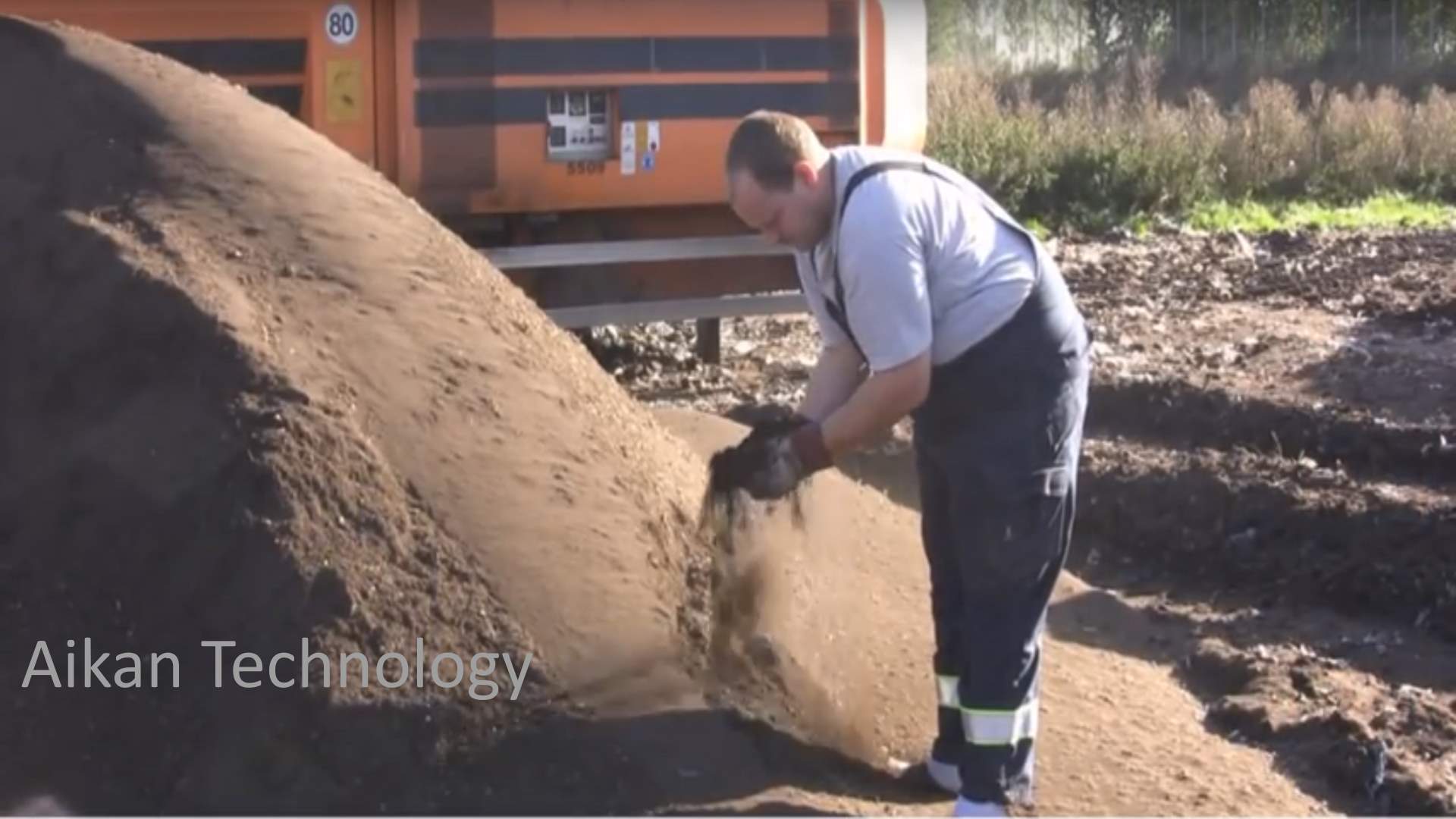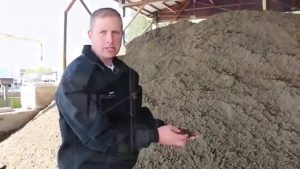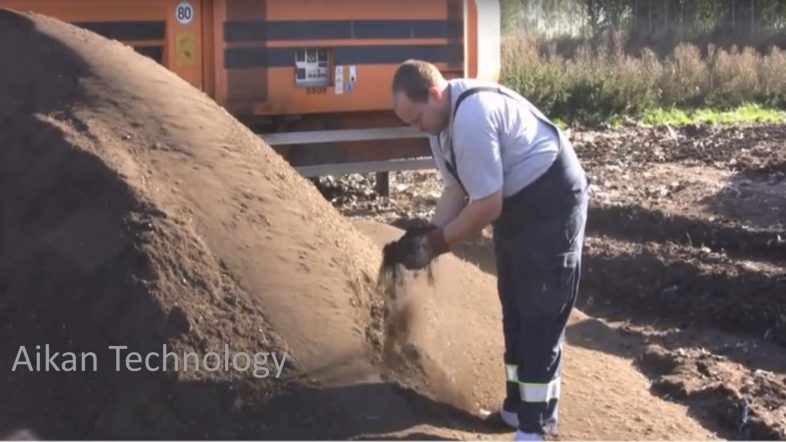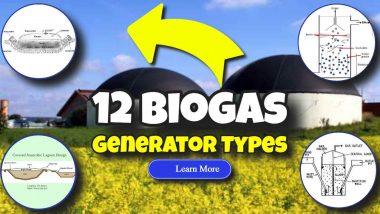Biogas digestate it's use, or disposal is often a vexed question for anaerobic digestion plant owners. Many consider their digestate (i. e. the solid and liquid AD Plant output) to be no more useful than for spreading on their fields. That may be a great use for it and will reduce chemical fertiliser bills.
Some, such as food waste AD plant operators, may actually see it as a liability.
But, the fact is that there may be a better use for it.
So here are 16 real uses for Biogas Digestate reported by WRAP. But, when regulatory compliance and marketing are done right, biogas digestate has far more uses than you ever imagined.
Market a product for some of these uses for biogas digestate, and we think that there is a BIG potential for profit. So, keep reading (or watch the video below) this, and tell us if at the end, if you don't then agree that biogas digestate can be exciting!
Watch this! It's our two part video of this article!
This is the second part of our video and article, so keep watching for the final “8 uses of biogas digestate which you probably never heard of”
Images courtesy Aikan Technology
1 – Home garden products
Composts produced from separated digestate fibre would provide a use for biogas digestate, which is a similar source of stabilised organic matter suitable for improving soil properties. A number of multi-purpose garden compost brands which include a percentage of digestate fibre are already available.
If mixed with woodchips, sawdust or straw the C:N ratio could be optimised, and replace the use of unsustainable peat-based media. However, some supplementing with added P and K, may be needed.
2 Horticulture: Landscaping

Co-composted separated fibre would provide an excellent source of organic matter to use in manufactured soils for landscaping and is the second of our uses for biogas digestate.
3 Horticulture: Commercial fruit and vegetable production
PAS100 green compost is used for mulching apple trees. Therefore, composted separated fibre from digestate produced by the anaerobic digestion process could be used for a similar purpose.
4 Horticulture: Compost teas
The use of compost teas in the production of a wide range of crops has become popular in the UK. This involves the use of a ‘broth’ of microorganisms such as fungi, nematodes, bacteria and protozoa to improve soil ecology and hence soil health, productivity and plant health.
Digestate separated fibre could potentially be used as a feedstock for the composting process from which compost teas are produced. So, for use in making compost teas is another of our listed uses for biogas digestate.
5 Horticulture: mushroom growing media
Digestate may find it hard to compete with animal manures as the N and C were less available.
However, there is a large market and the mushroom industry may actually be the largest user of composted organics in the UK.
6 Horticulture: A fertiliser for commercial nurseries and herbaceous shrubs

Vanderhaak biogas, via YouTube Creative Commons Licence.
Separated liquor would be more suitable than digestate fibre due to greater ease of infiltration into the soil giving more efficient use of nutrients.
However, supplemental P and K would be required so digestate liquor is not ideally suited to this purpose.
7 Forestry
Demand can be anticipated for digestate fertilisers, compost and some mulch in ‘urban forestry’ or tree planting for landscape and amenity purposes, notably on brownfield land.
8 Use on publicly owned flower beds and green spaces
There is potential for composted separated digestate fibre to be used as a bedding material in publicly owned parks and gardens and for mulching trees.
Separated liquor may be useful as a turf fertiliser, subject to considerations regarding odour.
This article (and the two videos) are based upon a WRAP Report on digestate, which is available from WRAP here.
9 – Use as fertiliser for organic crops and farms
While use is possible for digestate, this not a likely use, because it is unlikely that fertilisers containing digestate could be certified as organic, due requirements for the complete absence of non-GM ingredients.
10 – 1 Nutrient extraction via Struvite Recovery
A number of technologies exist to extract nutrients from digestate, and Struvite Recovery in particular can be viable, and produces a high-value fertiliser.
10 – 2 Nutrient extraction and fuel production
A Swedish technology developed to treat horse manure can also treat digestate.
This dewatering and nutrient extraction process, produces biomass fuel pellets and biofertiliser pellets. The value as fuel has been quoted in the £80-£120 per tonne, plus biofertiliser £80-£150 per tonne.
10 – 3 Algal growth for nutrient removal
A potential method of nutrient extraction from organic wastes is the production of proteinaceous biomass by cultivating algae in engineered ponds.
Harvested algal biomass is a high-grade protein which can be used as an animal feed, or as a slow-release fertiliser.
11 Construction material
Researchers at Michegan State University are developing construction materials from dried manure fibres of anaerobically digested animal manure.
They are working to develop medium density fibreboards (MDF) and wood-plastic composites (WPC).
12 Fuel
12-1 Cellulosic Ethanol Production
Bioethanol is the primary fuel used as a petrol replacement for road transport vehicles and is produced by sugar formation.
The major source of sugar for bioethanol production has until now been from energy crops, but this use of crops is being outlawed by EU legislation.
Waste biomass, including digestate fibre, is a source of cellulose, cellulose, and hemicellulose and other organic materials that can be used as a low cost feedstock for enzymic hydrolysis to produce sugar, for subsequent fermentation to bioethanol.
Recent research shows digestate is a better biomass source than switchgrass which is a common feedstock used currently.
12-2 Biodiesel production
While use is possible for digestate, there is little potential to produce biodiesel from digestate.
Digestate would be disadvantaged by its relatively low C:N ratio, as a basic requirement is a high C:N ratio of about 100, which is not met by digestate.
12-3 Digestate as solid fuel
Digestate fibre dried, and pelletised can be used as a solid fuel.
Dried in a drum-dryer using waste heat from biogas production, to 80-85% dry matter this can be a net fuel saver, when there is no better use for the AD plant heat.
This might be a useful option for digestate in hot dry climates where digestate can be left to dry in the summer sun.
13 Biopesticides production
Yes – even more surprisingly, digestate may be useful to the production of sustainable Biopesticides!
Replacing chemical insecticides with biological agents for pest control is considered desirable to improve environmental quality, food safety, human and animal health.
Here again digestate may have a role to play as it seems that there may be potential to produce biopesticides from anaerobically digested food and farm waste.
Conclusion
This article (and the two videos) are based upon a WRAP Report on digestate, which is available from WRAP here, and WRAP has provided a very thorough report.
We hope that by providing these videos we have helped broaden the thought process of our readers to see the possibilities that biogas digestate presents.
However, for most of these ideas, a substantial amount of further research would be needed, and for some, it would be necessary for investing in pilot studies and prototype designs to prove the concept.
Probably the easiest digestate sales option has in the past been for biogas plant operators to choose from options 1 to 3, above, subject to compliance with all regulatory requirements being achieved and market the AD plant's products into the home garden, and horticultural (non-food crop use), sectors.
Bio-gas digestates (BDSs) have emerged as a useful nutrient source for grain maize and could replace the nutrients in some soils. Nonetheless BDS cannot address shortages of nutrients that occur in the intensive cultivation soil. The dietary insufficiency was measured in phosphorus, magnesium sulphate, and calcium. BDS proved a powerful agent, extending the Mg pool and affecting K pool in maize compared to other grazing agents. Adding N-NO3 to maize has shaped the yields thus affecting yields in grain.
More About Anaerobic Digestion Digestate
Introduction
Under the principles of back to earth alternatives and circular economy, sustainable management of digestate from the organic part of municipal solid waste and food waste is possible.
Anaerobic fermentation is considered the best technological solution for fuel production utilizing renewable materials. The biogas industry is run on different organic compounds transformed into methane and CO2. It is called biogas. The EU Energy Policy aims to produce energy by using renewable fuels in future. Biogas should provide about 5% of all bioenergy generated. Agricultural biogas plants are used byproducts from farming only in saline digestion.
Global warming affects global energy production by reducing greenhouse gases and requires extensive development and recovery of value from historically underutilized resources. The FAO estimates that 1.3 billion tonnes of food waste annually are generated worldwide. This translates to 250 km3 of corresponding wastes of air and an increase in 3.3 billion tonnes in greenhouse gases ( CO 2e. ).
Anaerobic digestion is a dream come true because it provides both green energy and soil amendment. I've been asked if the material that comes out of a digester, known as digestate, is as useful for soils as compost or municipal biosolids (itself a digestate). My answer is yes. Anaerobic digestion is a method that is widely used in the treatment of municipal wastewater and this is one reason for that.
Recently, nitrogen recovery from these digestates as renewable fertilisers with high nutrient usage efficiency or as P-poor alternative fertilisers has gotten a lot of attention in order to meet both regulatory and commercial criteria while also generating internal revenue.
What is digestate used for?
Traditionally digestates are used as soil conditioners. Acidogenic digestate helps retain moisture in soils. It can break down aerobically into soils. Methanogenic digestate helps plants grow.
The agricultural value of biogas digestate solids (BDS) as a soil amendment is determined by their impact on soil fertility and mineral content in the edible portion of the crop. This theory was confirmed in a series of maize field studies done in Brody, Poland, between 2014 and 2016.
A subsurface drip irrigation system for tomato plants was successfully delivered through a Digestate biofertilizer. The red tomato yield in successfully treated biofertilizing was higher or comparable to the synthetic fertilizer-based control. A concentrated digestate bio fertilizing agent produced tomatoes with a significantly more complete total soluble content compared to the naturally fertile tomatoes.
There is also potential for the use of anaerobic digestion process digestate from dairy manure in suppressing soil-borne plant disease. Anim Sci J 89:1512–1518. https://doi.org/10.1111/asj.13092 Article Google Scholar 68. Nagarajan D, Lee D-J, Chang J-S (2019). Integration of anaerobic digestion and microalgal cultivation for digestate bioremediation and biogas upgrading has also been positively reported.
The parameters that contribute to the difference in the rate and/or degree of flocculation in the food waste and dairy manure digestate materials (e.g., ionic strength, particle size distribution, particle surface charge) need to be investigated further.
Is digestate a good fertilizer?
Digestate spreading is becoming a popular option for farmers looking to replace slurry spreading.
Choose a digester spreader to give your crops an organic fertilizer that improves the soil quality and produces optimum yields in general.
Sewage sludge (also known as biosolids), pig slurry, food scraps, and the organic part of solid waste are all nutritionally superior to digestate from fibrous feedstocks.
A study on the effects of biogas digestion solids based solids on maize has been published. This report is an update to an earlier version published here and the results have been verified. According to FAO and WRB, the studied ground is considered a typical Luvisol.
The annual precipitation for the growing season was 416 in 2015, 410 in 2015 and 417 in 2016, while the average was 317mm for longer periods. In 2015, the Maize vegetation suffered mainly due to rain during August. Its precipitation reached 15 mm with a concomitant temperature.
Organic nitrogen will be the primary kind of nitrogen in all of these compounds.
What is digestate fertilizer?
Digestive is an anaerophageal digestible substance which is useful as a fertilizer. The volume of digestion should be about 90% of the contents of the digesters.
Whether the feedstock is food waste, animal manure, or wastewater sludge, all anaerobic digestion systems follow the same basic principles.
The ammonia level of the digestate typically contributes for 60-80 percent of the overall nitrogen content, but it can be as high as 99 percent for a feedstock like kitchen food waste. Digestate is also said to contain higher phosphate and potassium levels than compost. The average P:K ratio is approximately 1:3. All of this adds up to digestate being a possible source of agricultural soil additives for specific crops.
What is liquid digestate?
Liquid digestates play a significant role in methanization. The product is marked by high levels of nontreated nitrogen, which is therefore useful as potentially waste for cultivation.
During the acidogenic stage, acidifying bacteria convert water-soluble chemical substances, including hydrolysis products, to short-chain organic acids such as formic, acetic, propionic, butyric, and pentanoic, alcohols such as methanol and ethanol, aldehydes, carbon dioxide, and hydrogen, resulting in acidogenic digestate. Acidogenesis also produces ammonia and hydrogen sulphide. This bacteria can function at pH levels ranging from 4.0 to 8.5.
Treatment with ultrasonication, for example, has been demonstrated to improve digestate solubilization as indicated by higher levels of soluble chemical oxygen demand (sCOD), soluble total organic carbon (sTOC), and soluble total nitrogen (sTN) released into the solution.
The carbon dioxide and other gases can be extracted from the methane from the anaerobic digestion process, leaving only the gas. Almost all of the natural gas supplied from the gas grid is made up of methane.
References
Future and prospects for biogas. Appl Microbiotechnology 85:894–885. Web page. Google Scholar. Is fruit waste used for biogas in plants? In Technol : 89-148. Google Scholars: Paul S, Dutta AA (2018). Challenges of lignocellulous biomass for aerobic digestion. Recycle 130164174. Site. Article Google Scholar. RELEL T & J MULKER (2010) Lifecycle Assessment of Biogas Digestion Processes. Research Conservation 58.91-10. Sites.
Potential of anaerobic digestate of dairy manure in suppressing soil-borne plant disease. Anim Sci J 89:1512–1518. https://doi.org/10.1111/asj.13092 Article Google Scholar Nagarajan D, Lee D-J, Chang J-S (2019) Integration of anaerobic digestion and microalgal cultivation for digestate bioremediation and biogas upgrading.
Article Dec 1988 Biomass F. Cecchi Pietro Traverso Joan Mata-Álvarez C. Zaror The state of the art of R&D in the field of anaerobic digestion of municipal solid waste in Europe.
Peng, Wei & Pivato, Alberto. (2019). Sustainable Management of Digestate from the Organic Fraction of Municipal Solid Waste and Food Waste Under the Concepts of Back to Earth Alternatives and Circular Economy. Waste and Biomass Valorization. 10. 10.1007/s12649-017-0071-2.
Article Google Scholar 8. Czekała W (2019) Processing of digested pulp from agricultural biogas plant. Innovative approaches and applications for sustainable rural development. Springer Earth System Sciences, New York, pp 371–385 Chapter Google Scholar 9. Koszel M, Lorencowicz E (2015) Agricultural use of biogas digestate as a replacement fertilizer. Agric Agric Sci Procedia 7:119–124.
The future agricultural biogas plant in Germany: a vision. Energies 12:1–32. https://doi.org/10.3390/en12030396 Article Google Scholar Fagerström A, Al Seadi T, Rasi S, Briseid T (2018) The role of anaerobic digestion and biogas green gas in the circular economy Kumar S, Malav LC, Malav MK, Khan SA (2015) Biogas slurry.
Sustainable Management of Digestate from the Organic Fraction of Municipal Solid Waste and Food Waste Under the Concepts of Back to Earth Alternatives and Circular Economy. Waste and Biomass Valorization. 10. 10.1007/s12649-017-0071-2.
Potential odour emission measurement in organic fraction of municipal solid waste during anaerobic digestion: relationship with process and biological stability parameters. Bioresour Technol 101:7330–7337.
Assessing Nutrient Use Efficiency and Environmental Pressure of Macronutrients in Biobased Mineral Fertilizers Céline Vaneeckhaute , … Erik Meers , in Advances in Agronomy , 2014
Article Google Scholar Goberna M, Podmirseg SM, Waldhuber S et al (2011) Pathogenic bacteria and mineral N in soils following the land spreading of biogas digestates and fresh manure. Appl Soil Ecol 49:18–25.
Effect of anaerobic digestion temperature on odour, coliforms and chlortetracycline in swine manure or monensin in cattle manure. J Appl Microbiol 112:705–715. https://doi.org/10.1111/j.1365-2672.2012.05250.x
[Article originally published January 2018. Updated January 2020.]






how much does it cost to set-up biogas power plant?
These are the very many uses for digestate and I have not seen more. I have ideas now, and your writing has good meaning I am sure. Good wishes, sir.
I see you have many ideas to save the nature. Here is my tip for you. Use candles periodically instead of electricity. This may seem a little drastic, but candles offer wonderful mood lighting during meals, and when you watch television, do you really need bright lights on as well? Be sure to use soy candles, however, because many paraffin-wax candles have toxins such as toluene and benzene that burn off into the air in your home. Soy candles cost a bit more, but they burn with no black soot, and they also burn right down to the end with no negative environmental impacts.
16 Uses for Biogas Digestate. Phew Mate! I was doubting there was even 1! Thanks you for the info.
Hi there friends.
Digestate comes in three forms – whole (looks similar to slurry), liquid (solids removed) or fibre (similar to compost), but the dominant form for agriculture is whole. Please tell your readers that it is essential to obtain a recent nutrient analysis before deciding how to use it, the nutrient content of the product will vary between farms.
My name is Peter Close I work for the Northern Ireland Environment Agency. Would you have any examples of several farms coming together on a regional scale to spread costs and focus on this material as a new product and look at distribution / delivery; say at a county level?
Peter Close – I did some research on “farms coming together on a regional scale” with ADBA, and answered your question in an email this evening. Look out for an email from …@anaerobic-digestion.com
Where can i buy digestate for my garden?
Not sure. Where do you live?
hello dear,
i’m currently working on a research on digestate from biogas as biofertilizer and experimenting on my little garden at home. i want to know how long it takes to incubate the mixed soil with digestate before planting my vegetables and do i need to water the mixed soil and digestate after mixing?
Chidinma – I am no expert on details of bio-fertilizer when it comes to applying it to plants. As far as I am aware on farms the digestate is sprayed on the crops without dilution and they get watered when it rains next. But, that’s only my guess. Sorry not be be more helpful. Perhaps another reader that has experience can add a better comment here.
Hi. If using as a plant feed best to dilute. A few UK reports which may help firstly focussed on small scale: http://www.wrap.org.uk/sites/files/wrap/2016.04.20%20Literature%20Review.pdf
and secondly field scale – all about how much to apply to meet the crop needs:
http://www.wrap.org.uk/sites/files/wrap/Digestate_compost_good_practice_guide_reference_version.pdf
Hi everyone,
I currently concluded a research on the use of solid digestate. I would further want to support the article by including the use of digestate for the production of bioplastics (most popular would be PHAs).